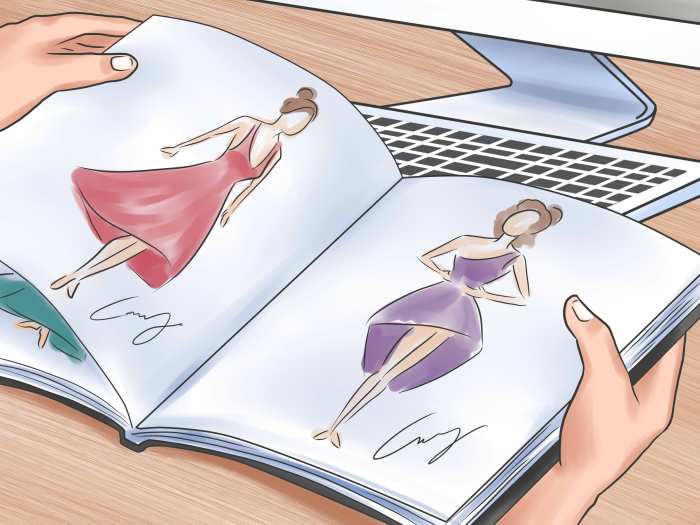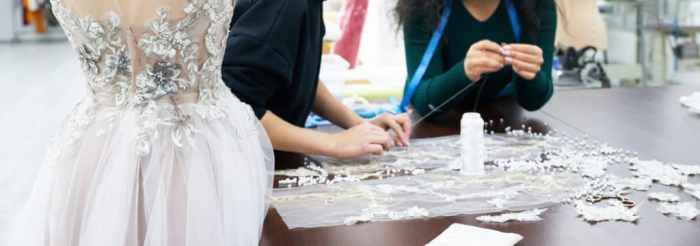How to Become a Wedding Dress Designer
Education and Training Pathways to Becoming a Wedding Dress Designer
How to become a wedding dress designer – Aspiring wedding dress designers can pursue various educational paths, each offering unique advantages and disadvantages. The choice depends on individual learning styles, financial resources, and time commitments. Formal education provides structured learning, while apprenticeships offer hands-on experience, and self-teaching allows for flexible learning tailored to personal interests.
Educational Pathways Comparison, How to become a wedding dress designer
The table below compares three common paths to becoming a wedding dress designer, highlighting their costs, time commitment, advantages, and disadvantages.
| Pathway | Cost | Time Commitment | Advantages | Disadvantages |
|---|---|---|---|---|
| Formal Fashion Design Program (Associate’s or Bachelor’s Degree) | High (Tuition fees, supplies) | 2-4 years | Structured curriculum, industry connections, comprehensive skill development, potential for scholarships | High cost, time commitment, potentially less hands-on experience initially |
| Apprenticeship | Variable (May involve a stipend or payment for services rendered) | 1-3 years (or longer) | Hands-on experience, mentorship from experienced designers, direct exposure to industry practices, potentially lower cost | Limited formal training, reliance on finding a suitable mentor, potential for inconsistent learning experiences |
| Self-Teaching | Low to Moderate (Cost of materials, online courses) | Variable (Highly dependent on dedication and learning pace) | Flexibility, self-paced learning, cost-effective, ability to focus on specific areas of interest | Requires strong self-discipline, limited access to feedback and mentorship, potential for skill gaps |
Skills Developed in Each Pathway
Regardless of the chosen pathway, several core skills are crucial for success. These include:
- Pattern Making: Creating accurate patterns to construct garments.
- Draping: Sculpting fabric on a dress form to create a three-dimensional design.
- Sewing Techniques: Mastering various sewing methods for different fabrics and construction details.
- Design Principles: Understanding elements like color theory, proportion, balance, and silhouette.
- Sketching and Technical Drawing: Effectively communicating design ideas through visual representations.
- Fabric Selection and Knowledge: Understanding the properties of various fabrics and choosing the right ones for wedding gowns.
Self-Taught Learning Curriculum Example
A self-taught curriculum should be structured and progressive. This example focuses on building a strong foundation and gradually tackling more complex projects.
- Fundamentals: Basic sewing techniques, pattern drafting for simple garments, fabric knowledge (online courses, books, YouTube tutorials).
- Intermediate: Draping techniques, advanced sewing (e.g., working with lace, beading), pattern alteration (online workshops, books, pattern-making software).
- Advanced: Designing and constructing a simple wedding dress, exploring different design styles, portfolio building (independent projects, collaborations with photographers).
Recommended resources include online courses from platforms like Skillshare and Udemy, books on pattern making and sewing, and YouTube channels dedicated to fashion design and sewing.
Developing Design Skills for Wedding Dresses
Success as a wedding dress designer requires a deep understanding of design aesthetics and the ability to translate concepts into tangible creations. This involves exploring various design styles, mastering sketching techniques, and creating compelling mood boards.
Wedding Dress Design Styles
Wedding dress styles vary widely, catering to diverse tastes and preferences. Some popular styles include:
- Bohemian: Flowing fabrics, lace details, relaxed silhouettes, often featuring earthy tones.
- Classic: Timeless elegance, clean lines, structured silhouettes, often featuring ivory or white fabrics.
- Modern: Minimalist designs, sleek silhouettes, innovative fabric choices, often incorporating geometric shapes.
- Vintage: Inspired by past eras, incorporating elements like beading, embroidery, and specific silhouettes from decades past (e.g., 1920s, 1950s).
Sketching and Design Concepts
Sketches serve as the initial visual representation of design ideas. Technical drawings provide more detailed specifications for construction. Techniques include pencil sketching, watercolor rendering, and digital illustration. Technical drawings typically include measurements, seam allowances, and construction details.
Creating a Mood Board
A mood board for a wedding dress collection visually communicates the overall aesthetic. For a “Romantic Garden” collection, the mood board might feature images of lush gardens, delicate floral patterns, soft pastel colors, flowing fabrics like silk chiffon and lace, and inspiration images of flowing gowns with delicate floral appliqués. The color palette would be dominated by soft pinks, creams, and greens, reflecting the romantic and natural theme.
Understanding the Wedding Industry: How To Become A Wedding Dress Designer
Success in wedding dress design requires a strong understanding of the bridal market, its key players, and current trends. This knowledge is crucial for tailoring designs to meet market demands and building successful business relationships.
The Bridal Market and Current Trends
The bridal market is dynamic, influenced by seasonal trends, social media, and evolving fashion preferences. Staying abreast of these changes is crucial for maintaining a competitive edge. For example, sustainable and ethically sourced fabrics are gaining popularity, alongside a growing demand for diverse sizing and body-positive designs.
Key Players in the Wedding Industry
Several key players contribute to the success of a wedding dress designer’s business:
- Bridal Boutiques: Retailers that sell wedding dresses.
- Wedding Planners: Professionals who organize weddings, often referring clients to designers.
- Photographers: Capture images of wedding dresses, crucial for marketing and showcasing designs.
- Fabric Suppliers: Provide the raw materials for dressmaking.
- Seamstresses and Pattern Makers (if outsourcing): Assist with production.
Resources for Staying Updated
Staying current on trends and industry news involves using various resources, such as:
- Fashion magazines and blogs: Publications specializing in bridal fashion.
- Industry trade shows: Events showcasing new designs and trends.
- Social media platforms: Following designers, boutiques, and influencers.
- Online forums and communities: Connecting with other professionals in the field.
Building a Portfolio and Brand

Source: wikihow.com
A strong portfolio and a well-defined brand are crucial for attracting clients and establishing a successful wedding dress design business. This involves showcasing design skills, building a unique brand identity, and developing a targeted marketing strategy.
Sample Portfolio Structure
A portfolio should showcase a variety of design styles and techniques. For example, it could include: a classic A-line gown featuring intricate beadwork, a modern sheath dress with clean lines and a unique neckline, a bohemian gown with flowing fabric and lace detailing, and a vintage-inspired gown with a fitted bodice and full skirt. Each design should be accompanied by detailed descriptions highlighting the design inspiration, fabric choices, construction techniques, and unique selling points.
Building a Strong Personal Brand

Source: internationalweddinginstitute.com
A strong personal brand communicates the designer’s unique style, values, and vision. This involves defining a clear brand identity, developing a consistent visual aesthetic (logo, color palette, typography), and creating a compelling narrative that resonates with the target audience. This could involve emphasizing sustainability, ethical production, or a specific design philosophy.
Marketing Strategy

Source: josabimariees.com
A comprehensive marketing strategy involves both online and offline channels. Online channels include a professional website, social media marketing (Instagram, Pinterest), and collaborations with wedding blogs and influencers. Offline channels include participation in bridal shows, networking with wedding planners, and collaborating with local boutiques.
Production and Business Aspects
The final stages of becoming a successful wedding dress designer involve understanding the production process, choosing appropriate manufacturing methods, and managing the business aspects of the enterprise.
Sourcing Fabrics and Materials
Sourcing high-quality fabrics is crucial for creating beautiful and durable wedding dresses. This involves researching fabric suppliers, considering factors like cost, availability, and sustainability. Different fabrics, such as silk, satin, lace, tulle, and organza, offer unique properties and aesthetics suitable for various design styles.
Manufacturing Methods: Custom-Made vs. Mass Production
Custom-made dresses offer personalized designs and fittings, catering to individual client preferences. Mass production involves creating multiple copies of a design, offering economies of scale but limiting customization. The choice depends on the designer’s business model, target market, and production capabilities.
Business Aspects of a Wedding Dress Design Business
Running a wedding dress design business requires attention to several key aspects:
- Pricing Strategies: Determining competitive and profitable pricing based on costs, design complexity, and market value.
- Client Communication: Maintaining clear and consistent communication with clients throughout the design and production process.
- Legal Considerations: Understanding contracts, intellectual property rights, and relevant regulations.
- Financial Management: Tracking expenses, managing cash flow, and planning for business growth.
Popular Questions
What is the average salary for a wedding dress designer?
Salaries vary greatly depending on experience, location, and the type of employment (freelance vs. employed). Researching industry averages in your specific area provides a more accurate estimate.
Aspiring to be a wedding dress designer requires a blend of artistic talent and technical skill; understanding fabrics and construction is key. To gain inspiration, consider browsing various styles, perhaps checking out the elegant options for formal Macy’s wedding guest dresses , which showcase current trends. This research can inform your design choices as you develop your own unique wedding gown aesthetic.
How long does it take to become a successful wedding dress designer?
Success depends on individual dedication and opportunities. While formal education can take several years, building a successful business requires ongoing effort and may take years to establish a strong reputation.
Do I need a formal fashion design degree?
While a degree is beneficial, it’s not strictly mandatory. Strong skills, a portfolio showcasing talent, and a business plan can prove equally effective. Consider your learning style and financial resources when choosing a path.
How do I find my niche in the wedding dress market?
Identify your design strengths and passions. Explore different bridal styles and target audiences. Consider specializing in a specific aesthetic or price point to differentiate yourself.



















